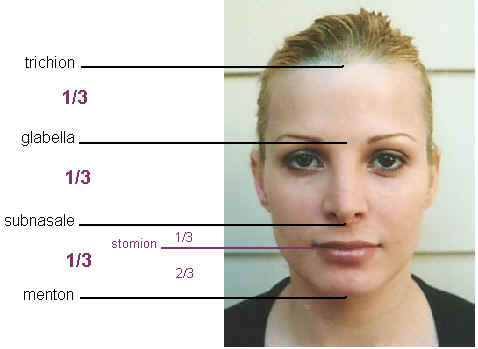|
Not everyone likes every
surgeon's noses so remember it is important to find what YOU like - not
what society deems attractive. Plus, you aren't going to agree with the
next person - hence variety. Just respect another's opinion of beauty
and if your opinion isn't asked for, don't butt in and try to
change the other's preferences. It can only cause strife or
friction.
Also please
remember - 'painting by the numbers' isn't what makes a good nasal
result - the artistic eye of the surgeon, communication with that
surgeon and realistic expectations from the patient will put you closer
to that desired aesthetic goal.
Again, *You
will more than likely need our Online
Rhinoplasty Glossary to
translate the terminology used. This
dictionary will load in a new window for your convenience:
|
"(a) The
distance from the infraorbital rim to the base of the nose
should be equal to the width of the nasal base (from the outside
of each nostril to nostril) and ½ the distance of the middle
third of the face (brow to the nasal base).
(b) The nasal length (radix to tip
or RT) should equal the distance from the stomion to menton
which equals 1.6 x TS (tip to stomion).
(c) Ideal tip projection (alar
crease to the tip) equals 0.66 x ideal nasal length (RT).
(d) The line from the mid-glabellar area to the menton
should bisect the nasal bridge, the nasal tip, and Cupids bow.
(e) The nasal dorsum should be
outlined by two slightly curved divergent lines extending from the
medial supraciliary ridges to the tip defining points.
(f) The width of the bony base is
approximately equal to 80% of the alar base.
(g) The width of the alar base
is equal to the intercanthal distance or one eye width.
(h) The alar rims should have
a slight outward flare in an inferior direction.
(i) Lines connecting the tip defining
points, the supratip break area, and the columellar lobular
angle form two equilateral triangles.
(j) A line outlining the alar
rims and columella resembles a gull in gentle flight.
(k) With the eyes in frontal gaze,
the nasofrontal angle lies at a level between the upper
eyelashes and the supratarsal crease.
(l) The nasal dorsum, in
women, lies approximately 2 mm behind and parallel to a line from
just above the nasofrontal angle to the tip defining
points. In men, the dorsum is slightly higher.
(m) 50-60% of the tip lies anterior
to a vertical line drawn adjacent to the most projecting portion
of a normally positioned upper lip.
(n) Tip projection equals alar
base width.
(o) Tip rotation is determined by the
degree of the nasolabial angle, measured as the angle
between vertical and a line drawn through the most anterior and
posterior edges of the nostrils (normal 95-100 degrees in women
and 90-95 degrees in men) (nasolabial angle is not the same as columellar
labial angle).
(p) The columellar-lobular angle
is approximately 45 degrees.
(q) On a basal view, the outline of
the nasal base forms an equilateral triangle; the lobular to
nostril ratio is 1:2.
(r) The upper lip projects 2 mm more
than the lower lip, and in women, the chin lies slightly posterior
to the lower lip; slightly stronger in men.
The distance from the mandibular angle to the menton
is ½ the distance from the menton to the natural hairline
(or trichion)."
above credit: Yale
University Medical Curriculum
|
Leonardo da Vinci's Facial Third
Formula
Get out your T square and
compass to do this exercise. This is actually more simple than the above
but you will need a lateral photo (side head shot) over your entire head
so that you can determine your Frankfort Horizontal Line.
- The width of nose at its base should be
approximately the distance between the eyes (medial canthus).
- The length of upper lip is about twice
that of lower lip and chin.
- Tip - Slight Upward Rotation : better
- Nasofacial angle = 36 degrees
- Nasofrontal angle = 120 degrees
- Nasomental angle = 130 degrees
- Mentocervical angle = 85 degrees
"Ideal"
Vertical Facial Dimensions

Ideally, my columella is a
little too long
Losing
Track Of What IS Attractive: When It Never Looks Good Enough
Please be careful if after several rhinoplasties, you just can't seem to
be satisfied. Sometimes it very well may be that you are not aware of what
looks attractive on you. Even if you get the EXACT nose that you asked for
and you still aren't happy, reconsider what it is you are truly desiring.
Rethink what it is you are really trying to achieve. Are there other
factors that you do not like. What were your original reasons for
rhinoplasty? Is this a functional matter? Is it a low self esteem issue.
Unfortunately, oftentimes when a mental or emotional issue is present -
you won't think there is. This is when it becomes unhealthy and dangerous.
No one wants to be told they
have an image disorder. Not me, not you - no one. But it IS important not
to rule this fact out. Please, just consider the possibility of a self
image disorder if after 2 rhinoplasties by 2 surgeons, or one very skilled
one, you are not happy with your results. Please read our section on BDD:
Beyond Typical Depression After Rhinoplasty
References
Yale University Medical
Curriculum - Rhinoplasty
Graylab Online Medical Dictionary - UK
Merriam-Webster Medical Dictionary
Leonardo da Vinci - Dimensions - rule of thirds, rule of fifths
Aesthetic Dimensions Analysis
Fibonacci Numbers - Ancient Understanding of Beauty
|
